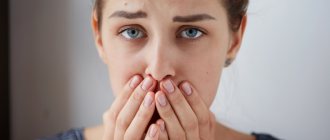The face becomes flushed with color and heat, the skin becomes the color of a tomato, and a telltale blush appears on the cheeks. The feeling of blushing in a stressful situation, from embarrassment or excessive attention, is familiar to many. Only some people do not attach importance to a minute physiological reaction, while others experience constant awkwardness and even shame. How to stop blushing for blushing?
What kind of disease is this
Fear of blushing is often confused with blushing syndrome. In contrast, erythrophobia is accompanied by fear.
It is a reaction of the nervous system to stimuli. A person can no longer independently control the processes in the body. He is afraid of making a bad impression on his interlocutor and is convinced that a red face repels others.
The fear of turning purple in the presence of people is psychological in nature.
There are two types of erythrophobia:
1. Classic . The whole face turns red. 2. Geographical . Certain areas turn purple.
This phobia gives rise to self-doubt, and, as a result, a person experiences neuroses and stress, and tries to avoid crowds of people.
There are other unpleasant consequences of this pathology:
• lack of desire to move forward; • complete withdrawal from interaction with society; • development of depression; • fear of expressing one's opinion; • constant dissatisfaction with oneself.
In rare cases, the patient experiences a feeling of hopelessness and begins to think about suicide.
Brief anatomical background and pathogenesis
When blood suddenly rushes into the dilated vessels of the subcutaneous tissue of the face, it turns red. This phenomenon is called blushing syndrome. Facial hyperemia occurs during physical activity, emotional stress (joy, shame, fear, etc.). Redness appears throughout the face evenly or in separate spots. Most often the cheeks turn red.
Erythrophobia is caused by facial hyperemia, and facial hyperemia is caused by erythrophobia. A vicious circle is formed. When a person is afraid of blushing in public, adrenaline is released. This neurotransmitter stimulates the sympathetic nervous system, increasing heart rate. The blood supply to the vessels improves, the face turns red. The fear of blushing in public is caused by serious psychological problems. Without finding out the underlying reasons, it is very difficult to get rid of fear.
Causes
Factors that provoke erythrophobia include:
• excessive shyness in childhood; • taking certain medications; • negative environmental impact; • allergies to food or cosmetics; • long exposure to the sun; • temperature changes; • drinking alcohol, coffee or strong tea; • eating spicy and hot food.
Redness itself is provoked by such health problems as:
• diabetes; • pathologies of the endocrine system, heart and blood vessels; • vascular defects of capillaries; • disorders of the nervous system; • failure of hormone levels; • carcinoid syndrome.
Cholerics, as well as people suffering from hypertension and gastrointestinal diseases, are most susceptible to phobias. Women during menopause, as well as fair-skinned people with blue eyes, are prone to it.
Why does fear arise?
The causes of this phobia are shrouded in mystery; the issue is still under consideration by scientists around the world. There is no consensus on the origin of the phobia. There are only theories that can partially explain why some people are afraid of recurring holes. Here are the main ones.
Biological hypothesis
A person is designed in such a way that his brain is constantly ready to evaluate what his eyes see and ears hear; this is a biological reaction to environmental changes that is unconscious to man. It is important for the survival of the entire species and individual. If a person is not capable of quickly analyzing changing conditions from the outside, then the likelihood of his absurd death will increase significantly.
Cluster holes themselves do not pose a threat, but are regarded as a kind of irritant. It is to this stimulus that the brain reacts. In clustered repeating holes, he can see a certain threat, the essence of which is not clearly understood, but this does not change the result - anxiety, excitement, and in severe cases, panic arises. The brain gives a command to the body - “run or attack.” But there is nothing to attack, the threat is not obvious, but the trypophobe is ready to run even now.
Personal experience, psychological reasons
Fear may be based on negative personal experiences. A person could be stung by bees while trying to remove honeycombs, he could be seriously poisoned by cheese with holes, or be injured by dried hard coral. If such a trauma was received in childhood, then there is a considerable probability that an incorrect reaction to a stimulus (in this case, an object with repeated holes) will be firmly entrenched in the subconscious.
The incident did not necessarily have to happen with the participation of an object with a porous structure, but in a moment of severe fright or panic, just such objects could come across the child’s eyes, and then, as in the cases described above, the incorrect cause-and-effect emotional connection is consolidated. For example, a child was punished and locked in a closet where washing sponges were kept. Contemplation of these sponges at a moment of high emotional intensity, fear, close to panic, could create the preconditions for the development of a phobic disorder, which returns every time a person sees either the sponge itself or anything that has a structure similar to it.
Strong impression
For this reason, the phobia also usually starts in childhood or adolescence. An impressionable, anxious personality type is favorable conditions for the development of a phobia. It is enough to get vivid, unforgettable impressions from watching a horror film, thriller, or even a film from the “Wildlife” series, which, for example, will tell about the life of bees, honeycombs, corals or frogs.
The cause of lasting and lasting fear can be a frightening photograph or someone’s stories about the danger that the corresponding objects may conceal. Often, children’s fear is provoked by the parents themselves, who scare him that something terrible might come out of the holes. The child grows up and with age comes the understanding that nothing and no one scary or terrible lives in porous objects, but fear can no longer be avoided.
Genetic predisposition
The hypothesis about the hereditary transmission of phobias hardly stands up to criticism, because so far scientists have not been able to discover genes that could be “suspected” in the development of fears. But an acquired genetic phobia is a reality. In other words, if one of the parents is afraid of cluster holes, afraid of clusters of small holes, then the child can acquire a similar form of reaction to these objects. After all, until a certain age (while basic fears are formed), the child sincerely trusts the model of perception of the world that his parents offer him. And if they say that honeycombs are scary, then they are.
Symptoms
The main sign of erythrophobia is facial redness, which can be uniform or appear in patches.
Changes in skin color can be seen in the décolleté and neck area. Some patients feel hot.
You can identify symptoms of fear of blushing in a person who is not confident in himself, has difficulty communicating with people, and chooses a job where he does not need to have contact with society. An accurate diagnosis can be made by a psychologist or psychotherapist after the examination and history taking.
Symptoms
As the name implies, the main symptom of erythrophobia is redness of the skin during any, even the weakest, experiences. A person feels that red spots are about to appear on his face, and worries about this, fearing that others will see them. This increases anxiety. Over time, nervous exhaustion develops, due to which the individual experiences anxiety even when nothing is happening. He's just constantly waiting to get excited and blush.
As erythrophobia develops, its manifestations intensify. The following symptoms appear:
- ever-increasing anxiety;
- panic and uncontrollable fear;
- trembling in hands;
- chills, cold sweat;
- difficulty breathing, shortness of breath;
- cardiopalmus;
- headache;
- dizziness;
- loss of connection with reality.
Eventually a panic attack develops. With erythrophobia, it only intensifies the experience and makes the manifestation of the disorder more pronounced. Sometimes the internal tension becomes so strong that a person simply cannot cope with it and faints.
How to get rid
You can eliminate the fear of blushing in front of people with the help of medications, surgery, effects on the psyche and folk methods.
Working with a psychotherapist is considered the most effective. It helps to get rid of the true causes of erythrophobia. A professional specialist can determine the degree of development of the phobia and choose the best way to solve the problem.
With the help of psychocorrection, you can learn to control your emotions and behavior, and calmly react to various situations.
Treatment for erythrophobia includes cognitive behavioral therapy, which helps eliminate bad thoughts and beliefs and changes the type of thinking. This is a very subtle method that requires a person’s conscious desire to be cured of the fear of blushing.
The following drugs are used as medications to combat anxiety and eliminate vasodilation:
1. Beta blockers. 2. Tranquilizers. 3. Alpha blockers.
Often the doctor prescribes a complex of vitamins . Thus, ascorbic acid has vasoconstrictor and anti-edema effects, rutin reduces the fragility of capillaries and strengthens them, vitamin K reduces their permeability. Such products are allowed to be used only after consultation with a specialist. Self-administration of medications may cause undesirable consequences.
Prevention of agoraphobia
Preventive (warning) measures are:
- developing a tolerant attitude towards stress;
- limited consumption of a number of foods;
- maintaining an active physical lifestyle.
Combating stressRules that limit the impact of stress on the body in the workplace are:
even distribution of work tasks throughout the day; allocating time for rest - the working day should include pauses that allow you to escape from the work process for a few minutes; correct prioritization - the most important tasks in terms of importance and volume must be planned at the beginning of the day; distribution of responsibility - the desire to do the entire amount of work independently will lead to overwork; timely nutrition - feeling hungry at work can cause irritability and reduce performance. Measures that help develop resistance to stress in the personal sphere are:
Measures to help develop resistance to stress in the personal sphere are:
- Problems in the family need to be clarified in order to correct the situation, and not to prove to others that you are right.
- Conflict situations should be resolved as they arise, and not postponed until later.
- Keeping a personal diary will help you control your own experiences and emotions.
- When faced with stress, you should calm down, which can be done using various relaxation techniques.
- The significance of negative events should not be overestimated. Often situations that are unpleasant for a person are not so when viewed from the outside.
- It is necessary to try to think objectively, regardless of external factors.
- When planning your personal life, you should set goals whose implementation does not depend on external circumstances and other people.
- The desire to control the situation under any circumstances can cause a breakdown. Therefore, if there is no control, you should not get too upset.
The role of certain foods in the prevention of agoraphobia Physical education in the prevention of agoraphobia Types of activities that will help prevent the disease are:
- aerobics;
- swimming;
- run;
- dancing;
- race walking.
What can trigger agoraphobia?
The most common factors that provoke agoraphobia are:
- experienced traumatic situations in childhood;
- disturbance of emotional balance as a result of stress;
- other psychosomatic diseases;
- character traits;
- disasters, accidents;
- taking medications;
- excessive consumption of alcoholic beverages.
alcoholism, pregnancy, menopause, and childbirth. Character traits that contribute to the development of agoraphobia are:
- suspiciousness;
- increased self-criticism;
- excessive demands on oneself;
- high level of responsibility;
- tendency towards introspection.
Factors that increase the risk of agoraphobia include:
- insufficient rest;
- chronic fatigue;
- uncontrolled use of drugs;
- unbalanced diet;
- disruptions in the functioning of the endocrine system.
sleeping pills
How to avoid repeated attacks of agoraphobia?
alprazolam, clonazepam Self-therapy measures, which are:
- working with destructive thoughts (dysfunctional beliefs);
- mastering techniques to combat fear;
- observance of systematicity.
Working with dysfunctional beliefs, independently or together with a doctor Activities that help control fear Activities that will help avoid attacks of agoraphobia are:
- visiting places where attacks occur;
- exercise “mountain of fears”;
- studying information about the disease;
- mastering breathing techniques.
breathing techniques and other methods taught by the doctor. The stages of breathing training are:
- take a comfortable position, standing or sitting;
- on the count of 1, 2, 3, 4, inhale through your nose;
- hold your breath and count to 7 in your head;
- Exhale deeply through your mouth, while tensing your abdominal muscles; the exhalation process should take at least 8 seconds;
- Continue alternating inhalation and exhalation until you feel relaxed.
Systematicity and activity, for example, the addition of other neurotic disorders
Operation
Treatment of erythrophobia involves surgery.
During the operation, the operation of the nodes of one of the parts of the autonomic nervous system is affected. It's called sympathectomy .
It is used in case of lack of effect from psychotherapy and medications. For geographic erythrophobia, this method is not recommended.
There are other contraindications:
• serious damage to the heart and blood vessels; • severe sclerosis of cerebral vessels; • some infections.
Surgery is performed under general anesthesia.
It has side effects:
• hypotension; • increased sweating; • reduced reaction to stress.
Reviews about the operation are predominantly positive. Many people have already eliminated unpleasant symptoms. Sympathectomy gives good clinical results and often relieves the patient of problems forever.
Patients note that it is important to choose a professional clinic for the operation and make sure that the doctors are experienced. Sympathectomy is often performed for reasons other than indications. Doctors do not always inform patients about possible conservative treatment methods, as well as what side effects the patient can expect after surgery. It is necessary to ensure that the medical facility is sufficiently equipped with the necessary equipment.
The inexperience of a specialist can lead to a technically incorrect operation. There is a possibility of damage to the accessory nerves, which leads to negative consequences.
Manifestations of mysophobia in humans
Excessive suspicion. People with this problem may spend a long time in the shower after contact with guests. The point in this case is not their adherence to many hours of water procedures, because even with a handshake, such persons are then ready to thoroughly wash their hands after the slightest touch to them.
Prohibition of entry into the home. It is difficult to go beyond the threshold into the house of a mysophobe, but this privilege must also be earned. In the apartment of a person with a fear of dirt, you can literally eat from the floor, because in terms of sterility it will give a hundred points ahead to any intensive care unit. Consequently, entry into such an abode of purity and order for a mere mortal is strictly prohibited.
Fear to go outside. A mysophobe, if he does not want to die of starvation, will still try, given such fear, to reduce his attempts to leave his home to a minimum. For him, going to the store or going to work is equivalent to a feat, which later makes him feel very bad.
Special uniforms. If a mysophobe nevertheless dares to go outside, then he is equipped for a dangerous outing from head to toe
To do this, even in the heat, he will wear clothes that are out of season, because the same dust will become a reason for him to panic and take additional precautions.
Refusal to shake hands. Such individuals may say hello in this way, but then fall into outright panic
They will wash their hands after contact, even with a close friend, for a long time, using all personal hygiene products.
Using disposable tableware. This factor is not a pathology if there is some kind of trip to nature, where there is no point in taking glass containers for food with you. However, mysophobes even manage to buy only such dishes at home, because they are afraid that otherwise they will get another portion of bacteria while eating.
Fear of touching objects. An emotionally healthy person will also not be eager to touch dirty things. However, mysophobe sees the source of infection in literally every little thing that surrounds him. Even if he has to come into contact with familiar household objects, then water, bacterial soap and various disinfectant sprays are used to destroy the imaginary infection.
Fear of contact with animals. For mysophobes, even well-groomed pets are carriers of all kinds of infections. They will react with indignation and disgust to a request to pet a cat or dog. Stray animals for them are generally the fiend of hell in its realistic embodiment, from which they will actively disown.
Treatment at home
Among the non-traditional means, the following methods can be distinguished:
1. Mint decoction. You need to chop 1 tablespoon of mint leaves and pour a glass of boiling water over it. The resulting composition is kept in a water bath for 15 minutes, and then cooled and drunk half a glass in the morning and evening. 2. Hardening. It is necessary to douse yourself with cool water every morning, gradually lowering its temperature. In the evening a contrast shower is shown. 3. Yoga, breathing exercises. These methods will increase self-confidence and reduce unwanted heartbeat.
It is necessary to exclude massage, hot baths and compresses.
Fear of blushing leads to a deterioration in the quality of life and the development of depression. Therefore, it is necessary to treat it completely using modern methods of therapy. It is worth contacting a psychotherapist who will help you find the essence of the problem and relieve unpleasant symptoms.
Consequences of erythrophobia
Redness of the face causes severe discomfort in a person. Among the symptoms of erythrophobia are growing obsessive anxiety, in which thoughts are blocked and a desire to run away and hide appears. Erythrophobia leads to consequences:
- Lack of self-confidence, a feeling of inferiority in front of the immediate environment.
- Refraining from speaking in front of people, from expressing one’s opinion, even if one is confident in its correctness.
- Lack of career advancement due to refusal of new responsibilities associated with the need to speak in front of the public. Professional unfulfillment.
- Complete refusal to communicate, self-isolation.
- Alcoholism.
- Depression, the appearance of suicidal thoughts.










